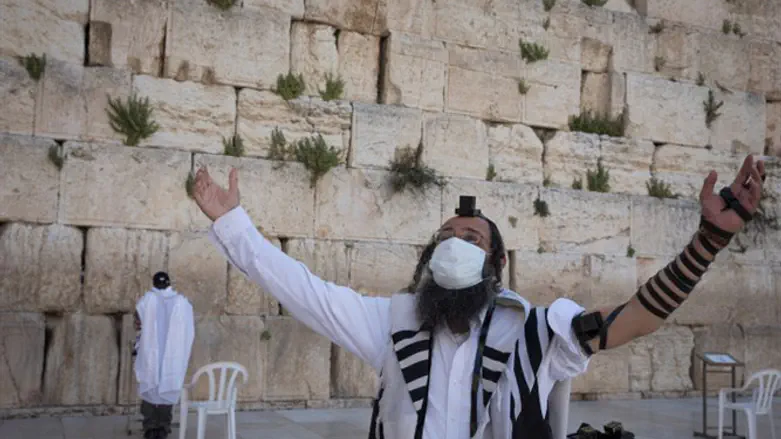
Co-authors: Edward C. Halperin, MD, MA; Alan Kadish, MD; and Rabbi Moshe Krupka
Simchas, or Simchat, Torah, the “Rejoicing of the Torah” begins on the evening of October 10th and concludes the following evening. The holiday marks the conclusion of the annual cycle of Torah readings and the beginning of the new cycle. The last sections of the book of Deuteronomy are read along with the first section of the book of Genesis. It is customary in many synagogues to mark Simchas Torah with members of the congregation leaving their seats to joyously dance and sing with the Torah scrolls while passing these scrolls from one congregant to another. Some synagogues call the children in attendance forward to gather with the Torah scrolls underneath an outstretched tallis (prayer shawl), symbolic of a wedding canopy. The dancing and singing often lasts for hours.
As physicians and leaders of the Touro College and University System and New York Medical College, we view the approach of Simchas Torah and the preceding holidays of Succos and Shemini Atzeres through a lens that focuses our attention simultaneously on our roles as Jews and medical professionals. We are particularly concerned in light of the increasing COVID-19 infection rates which were reported on September 30th in Orthodox Jewish neighborhoods of New York State - rates which significantly exceed baseline rates.
Densely populated areas, large families living together and an environment that values community and promotes frequent social gatherings and collaborative learning all favor the spread of a virus which has already killed over one million people around the world, among them many members of the observant Jewish community. Several months of relatively low rates of new cases of COVID-19 infection have lulled some members of the community into a false sense of “security”. The data recently reported, showing infection rates that are up to five times higher in Orthodox Jewish neighborhoods than other areas, should serve as a wake-up call.
The upcoming holiday is traditionally characterized by community engagement and unbridled celebration. We rejoice in the Torah and its gifts with a joy unmatched by other days of the year. It is thus customary to engage in
- public singing, which discharges potentially contaminated droplets into the air;
- dancing, which increases the respiratory rate and respiratory volume and thus promotes more vigorous dispersal of these droplets;
- and the possibility of people handing Torah scrolls from one person to another without washing their hands or sanitizing the cloth covers of the scrolls in between these hand-offs.
These conditions will create a veritable human petri dish that will promote spread of COVID-19 with potentially fatal consequences.
We believe, in the midst of the pandemic, that a true celebration of Torah would be to focus on the values and scholarship that the Torah and its ethos instill in our lives. At the forefront of these is the value that Jews place on the preservation of life.
This year it is essential for synagogue and Rabbinical leadership 
We believe, in the midst of the pandemic, that a true celebration of Torah would be to focus on the values and scholarship that the Torah and its ethos instill in our lives. At the forefront of these is the value that Jews place on the preservation of life. to plan on small, socially distanced gatherings with mandatory mask wearing; to curtail group dancing; and to have one person hold a Torah scroll and circle for hakafos without handing scrolls from one person to another.
to plan on small, socially distanced gatherings with mandatory mask wearing; to curtail group dancing; and to have one person hold a Torah scroll and circle for hakafos without handing scrolls from one person to another.
How shall we create the excitement and joy that every child associates with Simchas Torah?
We submit that this is a time to think about nuclear family celebrations; and about socially distanced outdoor concerts or online programs during Chol HaMoed. If the pandemic has taught us anything, it is to reach inside ourselves and discover the strengths we never knew we had and to think deeply about what is truly important to us.
While in past years, some lose themselves in the group revelry of Simchas Torah celebrations, this year all of us are compelled to reflect on our individual connection to the Torah and its commandments and to articulate these to our children.
Now is the time for the Jewish community to nurture its traditional values while recognizing the reality of the pandemic and the biblical imperative to protect our lives and the lives of those around us.
This Simchas Torah we must celebrate our vibrant and enduring faith in a healthy and meaningful way. Doing so demonstrates to our children and broader society the treasured Torah ideals that sustain our people.
Alan Kadish, MD is the President, Edward C. Halperin, MD, MA is the Provost for Biomedical Affairs and Rabbi Moshe Krupka is the Executive Vice President of the Touro College and University System, the largest university system under Jewish auspices in the United States. New York Medical College, which is part of the Touro System, is led by Dr. Kadish as President and Dr. Halperin as Chancellor/CEO.


